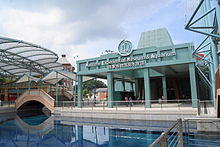The Maritime Experiential Museum
The Maritime Experiential Museum ( Chinese : 海事 博物馆 及 水族馆) is a museum on Sentosa Island in Singapore that exhibits some of the 60,000 artifacts recovered from the Belitung shipwreck .
museum
The museum opened on October 15, 2011 and is used to exhibit, research and preserve the found objects. The museum has been closed for restoration work from April 15, 2017 until the end of 2017. [outdated]
Shipwreck
The Belitung shipwreck was found in 1998 by sea cucumber fishermen diving in the shallow water off the coast of the island of Belitung near Java . The wreck was excavated by Tilman Walterfang , with about 60,000 items found on site.
The Jewel of Muscat is an accurate reproduction of the Belitung shipwreck of an Arab dhow . It was built by Mike Flecker , who participated in the recovery, in collaboration with the governments of Oman and Singapore.
charge
Due to Tilman Walterfang's objectives, the load was not sold or auctioned in parts, but sold to collectors in one piece. It was stored in a private warehouse for six years while the finds were cleaned, desalinated and preserved in New Zealand .
The lost and found items have been owned by the Sentosa Leisure Group since 2005 and are exhibited in collaboration with the Singapore Tourism Board . They were purchased for approximately US $ 32 million and first exhibited from February 19 to July 31, 2011 at Singapore's ArtScience Museum in Marina Bay Sands in an exhibition on the subject of Shipwrecked: Tang Treasures and Monsoon Winds.
The Sackler Gallery of the Smithsonian Institution wanted to exhibit the finds from the cargo for the first time in the USA in early 2012 for the 25th anniversary of the Smithsonian Museum . On June 28, 2011, however, it was announced that the exhibition would be postponed after archaeologists and anthropologists from the American National Academy of Sciences warned that the exhibition could damage the reputation of the institution due to the still controversial circumstances surrounding the recovery.
Opponents of the exhibition criticized that the recovery had commercial motives and was carried out so quickly that a lot of scientific information about the crew and cargo was lost forever. The supporters of the exhibition, however, were of the opinion that the recovery had taken place on behalf of the Indonesian government and in accordance with the Indonesian laws valid at the time. Walterfang admitted that the overall situation could without any doubt be described as not ideal (“the overall situation would without doubt be described as 'less than ideal'”) and that the Indonesian government had ordered a quick rescue for fear of looting (“ the Indonesian government, fearful of looting, ordered Seabed Explorations to begin an immediate round-the-clock recovery operation. ").
Web links
Individual evidence
- ^ The Maritime Experiential Museum ™ . ( Memento of the original from September 12, 2017 in the Internet Archive ) Info: The archive link was inserted automatically and has not yet been checked. Please check the original and archive link according to the instructions and then remove this notice.
- ↑ Jewel of Muscat . In: WoodenBoat . No. 217, November-December 2010, pp. 80-83.
- ↑ Sentosa Proceeds to Buy 9th Century Treasure . Sentosa. April 8, 2005. Accessed February 17, 2010. ( Page no longer available , search in web archives )
- ↑ CHINA MARITIME SILK ROAD MUSEUM . The Australian National University. Retrieved February 17, 2010.
- ^ Smithsonian and Singapore Organize World Tour of Shipwreck Treasure . Smithsonian Institution. Archived from the original on September 27, 2010. Retrieved June 28, 2011.
- ↑ Kate Taylor: Shipwreck Show Postponed , The New York Times. June 28, 2011. Retrieved July 15, 2011.
- ↑ Kate Taylor: Archaeologists Criticize Smithsonian Over Java Objects , The New York Times. March 10, 2011. Archived from the original on July 10, 2011. Retrieved July 15, 2011. "Three archaeological associations and three of the Smithsonian's internal research organizations have written to the Smithsonian's secretary, G. Wayne Clough, opposing the exhibition, arguing , among other things, that because of the methods employed by Seabed Explorations, valuable scientific information was lost. "
- ↑ a b c Kate Taylor: Treasures Pose Ethics Issues for Smithsonian . In: The New York Times , April 24, 2011, pp. 1-2. Retrieved July 15, 2011.
- ^ Smithsonian Hosts Discussion on Issues Surrounding the Exhibition of the Belitung Cargo . In: Shipwrecked: Tang Treasures and Monsoon Winds , The Smithsonian Institution, April 25, 2011. "Found in shallow water, the shipwreck was immediately vulnerable to looting and accidental destruction from fishing activity. Recognizing the danger to the site, Indonesian authorities granted a license to a commercial salvage company to recover the ship and its cargo. "
Coordinates: 1 ° 15 '30 " N , 103 ° 49' 13.8" E




